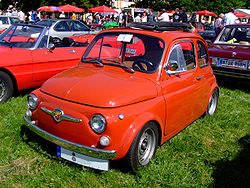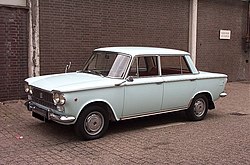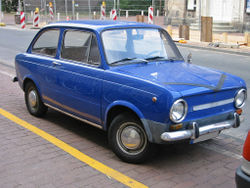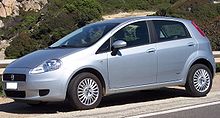List of Fiat passenger cars
From Wikipedia, the free encyclopedia
Fiat 509
History
Fiat
demonstrates the intrinsic biblical-endorsed power of words through a
simple spelling exercise. Fiat. Simple, isn't it? It sound whole and
commanding and besides being and acronym for Fabbrica Italiana
Automobili Torino, it also means “let there be” in Latin. Mimicking the
Genesis show, episode 1, “Let there be light”, a group of skilled
business men who bought the factory during the early 1910s, said “Let
there be cars”. And there were cars alright.
Fiat 1899 to 1911
The charter of Società Anonima Fabbrica Italiana Automobili Torino or Fiat, was signed on July 11, 1899. Giovanni Agnelli was
on the Board of Directors, but quickly distinguished himself as the
Company's innovator. He was determined Fiat would be highly successful
and had great strategic vision. Because of these qualities, he
became Managing Director of Fiat in 1902.
The charter of Società Anonima Fabbrica Italiana Automobili Torino or Fiat, was signed on July 11, 1899. Giovanni Agnelli was on the Board of Directors, but quickly distinguished himself as the Company's innovator. He was determined Fiat would be highly successful and had great strategic vision. Because of these qualities, he became Managing Director of Fiat in 1902.
Fiat's First Factories and Races
In 1900, the first Fiat factory opened in corso Dante, in Turin, with
a workforce of 150 people. Fiat saw 24 cars roll off the assembly line
that first year, including the company's first model, the 3 ½ CV.
By 1904, a Fiat logo had been designed as an oval with a blue
background. When Italy hosted the first Car Tour of the country, nine
Fiats crossed the finish line. By 1902, driver Vincenzo Lancia won the
Sassi-Superga uphill race, in the famous Fiat 24 hp model. Giovanni
Agnelli, President of Fiat, represented the company on the racetrack,
driving an 8 hp Fiat in the second Italian Car Tour and set a record in
that race.
In 1908, Fiat opened the Fiat Automobile Company in the US. The Company grew in leaps and bounds: at that time, a Fiat was a luxury item in
America, costing thousands more than the average domestic car of the
period. Fiat continued to grow at a swift rate and it wasn't long before
the company expanded its product line with trucks, trams, marine
engines and commercial vehicles.
Towards the end of Fiat's early production period, the company was to undergo some changes, and overhaul its production. Fiat began fitting its cars with electrical accumulators, and also patented the cardan transmission.
The first FIAT
branded automobile rolled out the factory sometime in 1901. Engineered
by talented Ceirano employee Faccioli, the coach-looking car was powered
by a 2 cylinder archaic Boxer 3 hp engine. The investment group heads
approached Faciolli on developing a front-engined vehicle. Faciolli's
response was not the expected one: he resigned.
Like any company
would have done, a replacement was sought and found in the blink of an
eye. Enrico took on the job and in a year's time he presented a new 1.2
liter four cylinder model, developed with technology borrowed from
Mercedes.
As time went by, the company gained in popularity and
although it was becoming bigger by the day, it still hadn't exited its
lengthy development and research stages. After many tryouts using 4 and 6
cylinder models, FIAT was ready to reveal its first mass-produced car,
the 1912 “Tipo Zero”.
Pre-war time was soon to be over and FIAT
would plunge in boringly new production stages to cover for aircraft and
tank demands. Post-war times however would bring Fiat lots of
sales-figures related merriment – the 501 Cavalli designed model was
built in over 45,000 units by 1926. After experimenting with some floppy
luxurious big engined models, Fiat resumed the development of its
highly popular models. The result was the 509, a light weight vehicle
that exceeded every FIAT sales record to that time: by 1929, it had sold
in more than 90,000 units.
A series of newer models that matched
or even surpassed the popularity of those before them were later
released, some of the most notable having been the 1932 Tipo 508
Ballila. Sporting 995cc 25hp and 36 hp engines, the car was adopted by
foreign producers. License-built rebadged versions of the Ballila were
successfully sold in Germany, Czechoslovakia and France.
A few
years before the WWII outbreak, FIAT was quick to release the long lived
1500 and Tipo 500 models, the latter having stayed almost unaltered
until 1948. When the war came Fiat was enjoyed an even greater
popularity thanks to its top-selling models at the time, the 500 and the
1100, almost known as the Millecento. Although no major improvements
were made in the immediate post-war years, the Italian company reached
the amazing threshold of 1 million units of the 600 model – the Topolino
replacement -sold.
Still, Fiat had now ended growing. The 1957
released twin-cylinder Nuova 500 model was built in over 3 million
units. In the same tradition of developing immensely popular models,
FIAT launched the 124 in 1966, a car that would become one of the most
widely known, right next to the 500. The Fiat sports cars had their own
share of acclaim, especially the Dino V6 equipped with the 1987 cc
Ferrari double overhead camshaft engine.
Speaking of Ferrari, it
was later absorbed by Fiat, in 1969 to be precise. The same year, Lancia
was acquired. Having turned into a large group, FIAT co-opted Abrth as
well in 1971. Presently, Fiat is developing a new range of sedans and
city cars and has hi the jackpot with the rival of the 500 and the Punto
models.
In 1908, Fiat opened the Fiat Automobile Company in the US. The Company grew in leaps and bounds: at that time, a Fiat was a luxury item in America, costing thousands more than the average domestic car of the period. Fiat continued to grow at a swift rate and it wasn't long before the company expanded its product line with trucks, trams, marine engines and commercial vehicles.
Towards the end of Fiat's early production period, the company was to undergo some changes, and overhaul its production. Fiat began fitting its cars with electrical accumulators, and also patented the cardan transmission.
The first FIAT branded automobile rolled out the factory sometime in 1901. Engineered by talented Ceirano employee Faccioli, the coach-looking car was powered by a 2 cylinder archaic Boxer 3 hp engine. The investment group heads approached Faciolli on developing a front-engined vehicle. Faciolli's response was not the expected one: he resigned.
Like any company would have done, a replacement was sought and found in the blink of an eye. Enrico took on the job and in a year's time he presented a new 1.2 liter four cylinder model, developed with technology borrowed from Mercedes.
As time went by, the company gained in popularity and although it was becoming bigger by the day, it still hadn't exited its lengthy development and research stages. After many tryouts using 4 and 6 cylinder models, FIAT was ready to reveal its first mass-produced car, the 1912 “Tipo Zero”.
Pre-war time was soon to be over and FIAT would plunge in boringly new production stages to cover for aircraft and tank demands. Post-war times however would bring Fiat lots of sales-figures related merriment – the 501 Cavalli designed model was built in over 45,000 units by 1926. After experimenting with some floppy luxurious big engined models, Fiat resumed the development of its highly popular models. The result was the 509, a light weight vehicle that exceeded every FIAT sales record to that time: by 1929, it had sold in more than 90,000 units.
A series of newer models that matched or even surpassed the popularity of those before them were later released, some of the most notable having been the 1932 Tipo 508 Ballila. Sporting 995cc 25hp and 36 hp engines, the car was adopted by foreign producers. License-built rebadged versions of the Ballila were successfully sold in Germany, Czechoslovakia and France.
A few years before the WWII outbreak, FIAT was quick to release the long lived 1500 and Tipo 500 models, the latter having stayed almost unaltered until 1948. When the war came Fiat was enjoyed an even greater popularity thanks to its top-selling models at the time, the 500 and the 1100, almost known as the Millecento. Although no major improvements were made in the immediate post-war years, the Italian company reached the amazing threshold of 1 million units of the 600 model – the Topolino replacement -sold.
Still, Fiat had now ended growing. The 1957 released twin-cylinder Nuova 500 model was built in over 3 million units. In the same tradition of developing immensely popular models, FIAT launched the 124 in 1966, a car that would become one of the most widely known, right next to the 500. The Fiat sports cars had their own share of acclaim, especially the Dino V6 equipped with the 1987 cc Ferrari double overhead camshaft engine.
Speaking of Ferrari, it was later absorbed by Fiat, in 1969 to be precise. The same year, Lancia was acquired. Having turned into a large group, FIAT co-opted Abrth as well in 1971. Presently, Fiat is developing a new range of sedans and city cars and has hi the jackpot with the rival of the 500 and the Punto models.
Contents
1899–1929
- 1899–1900 Fiat 4 HP (sometimes known as Fiat 3 ½ CV)
- 1900–01 Fiat 6 HP
- 1901–02 Fiat 8 HP
- 1901 Fiat 10 HP
- 1901–02 Fiat 12 HP
- 1903–05 Fiat 24-32 HP
- 1903–06 Fiat 16-20 HP
- 1903–06 Fiat 16-24 HP
- 1903–06 Fiat 60 HP
- 1905–08 Fiat Brevetti
- 1907–08 Fiat 28-40 HP
- 1908–09 Fiat 35-45 HP
- 1908–10 Fiat 20-30 HP
- 1908–10 Fiat 1 Fiacre
- 1908–10 Fiat 50 HP
- 1909–12 Fiat Brevetti tipo 2 or 15-25 HP
- 1910–12 Fiat Tipo 1 or 12-15 HP
- 1910–12 Fiat Tipo 2 or 15-20 HP
- 1910–12 Fiat Tipo 3 or 20-30 HP
- 1910–18 Fiat Tipo 4 or 30-45 HP
- 1910–16 Fiat Tipo 5 or 50-60 HP
- 1910–14 Fiat Tipo 6 or 30-45 HP
- 1912–15 Fiat Zero or 12-15 HP
- 1912–15 Fiat Tipo 1 A or 12-15 HP
- 1912–20 Fiat Tipo 2 B or 15-20 HP
- 1912–21 Fiat Tipo 3 A
- 1912–15 Fiat Tipo 3 Ter
- 1915–20 Fiat 70
- 1919–26 Fiat 501
- 1919–25 Fiat 505
- 1919–25 Fiat 510
- 1920–25 Fiat 510 S
- 1920–22 Fiat 1T Taxi
- 1921–22 Fiat 520 "Superfiat"
- 1921–26 Fiat 501 S
- 1921–26 Fiat 501 SS
- 1922–27 Fiat 519
- 1922–24 Fiat 519 S
- 1923 Fiat 501 C
- 1923–26 Fiat 502
- 1925–29 Fiat 509
- 1925–28 Fiat 509 S
- 1926–27 Fiat 503
- 1926–27 Fiat 507
- 1926–28 Fiat 512
- 1927–29 Fiat 520
- 1928–30 Fiat 520 T
- 1928–31 Fiat 521
- 1928–29 Fiat 525
- 1929–31 Fiat 525 N
- 1929–31 Fiat 525 S
- 1929–31 Fiat 525 SS
- 1929–32 Fiat 514
- 1929–32 Fiat 514 S
1930–1939
- 1931 Fiat 522
- 1931 Fiat 524
- 1932 Fiat 508 Balilla
- 1933 Fiat 518
- 1933 Fiat 518 Ardita
- 1934 Fiat 527
- 1934 Fiat 508 S
- 1936 Fiat 1500
- 1937 Fiat 100-12
- 1937 Fiat 508 C Balilla 1100
- 1937 Fiat 500 "Topolino"
- 1938 Fiat 2800
- 1939 Fiat 250
1948–1965
- 1948 Fiat 1100 S Coupé
- 1948 Fiat 500
- 1949 Fiat 1500 E
- 1950 Fiat 1400
- 1952 Fiat 1900
- 1952 Fiat 8V
- 1953 Fiat 1100/103
- 1954 Fiat 1900 Diesel
- 1955 Fiat 1100 TV Spider
- 1955 Fiat 600
- 1955 Fiat 600 Multipla
- 1956 Fiat 600 D Multipla
- 1957 Fiat 1200 Spyder
- 1959 Fiat 1100
- 1959 Fiat 1200 Spyder
- 1959 Fiat 1400 B
- 1959 Fiat 1500 S
- 1959 Fiat 1800
- 1959 Fiat 2100
- 1959 Fiat 2100 Coupé Vignale
- 1959 Fiat 750 Berlina Abarth
- 1959 Fiat Nuova 500 Sport
- 1960 Fiat 1500 Cabriolet
- 1960 Fiat 500 Giardiniera
- 1961 Fiat 2300 Berlina
- 1961 Fiat 2300 Coupé
- 1961 Fiat 2300 S Coupé
- 1961 Fiat 1300
- 1961 Fiat 1500
- 1963 Fiat 1600 Cabriolet
- 1963 Fiat 1600 S Coupé
- 1963 Fiat 2300 Berlina Speciale
- 1963 Fiat 600
- 1963 Fiat 600 D Multipla
- 1964 Fiat 850
- 1965 Fiat 850 Coupé
- 1965 Fiat 850 Spider
Fiat Dino Coupé
1966–1979
- 1966 Fiat 124 1200
- 1966 Fiat 124 Coupé 1400
- 1966 Fiat 124
- 1966 Fiat 124 Spider 1400
- 1966 Fiat 2300 B Familiare
- 1966 Fiat 1100 R
- 1966 Fiat Dino Spider
- 1967 Fiat 125
- 1967 Fiat 125 Special Berlina
- 1967 Fiat 1500 Cabriolet
- 1967 Fiat Dino Coupé
- 1968 Fiat 1500 L Berlina
- 1968 Fiat 850 Sport Coupé
- 1968 Fiat 850 Sport Spider
- 1968 Fiat 850 Super Berlina
- 1969 Fiat 124 Coupé 1600
- 1969 Fiat 124 Spider 1600
- 1969 Fiat 128 Estate
- 1969 Fiat 128 Saloon
- 1969 Fiat 130 Saloon
- 1969 Fiat Dino Coupé 2400
- 1969 Fiat Dino Spider 2400
- 1970 Fiat 124 Special T
- 1971 Fiat 127
- 1971 Fiat 128 1100 SL Coupé
- 1971 Fiat 128 1300 SL Coupé
- 1971 Fiat 128 Rally
- 1971 Fiat 130 Coupé
- 1971 Fiat 130 Coupé Automatic
- 1972 Fiat 124 Abarth Rally
- 1972 Fiat 124 Coupé 1800
- 1972 Fiat 124 Spider 1800
- 1972 Fiat 127 L
- 1972 Fiat 500 L
- 1972 Fiat 850 Familiare
- 1972 Fiat X1/9
- 1973 Fiat 126
- 1973 Fiat 132
- 1974 Fiat 133
- 1975 Fiat 130 Opera
- 1975 Fiat Mirafiori 1600 CL
- 1976 Fiat 131 Abarth
- 1976 Fiat 132 1800 ES
- 1977 Fiat 132 2000 GLS
- 1977 Fiat Fiorino (first generation)
- 1976 Fiat 370.12.26 coach
- 1978 Fiat 128
- 1978 Fiat Ritmo
- 1978 Fiat Mirafiori Sport
- 1979 Fiat 124 Spider 2000
- 1979 Fiat 132 Diesel
- 1979 Fiat Campagnola
- 1979 Fiat Campagnola Lunga
- 1979 Fiat Mirafiori 1300 CL
- 1979 Fiat Supermirafiori
1980–1989
Fiat Cinquecento Sporting
- 1980 Fiat Panda 750
- 1980 Fiat Strada 75 CL
- 1980 Fiat Supermirafiori
- 1980 Fiat 126
- 1981 Fiat 131 Mirafiori 1300 L
- 1981 Fiat 131 Racing
- 1981 Fiat Strada Abarth 125 TC
- 1982 Fiat 127 1300 Sport
- 1982 Fiat Abarth Volumetrico 131
- 1982 Fiat Argenta
- 1982 Fiat Campagnola Diesel
- 1982 Fiat Panda 30
- 1982 Fiat Strada 105 TC
- 1982 Fiat X1/9 (US)
- 1983 Fiat Regata
- 1983 Fiat Uno
- 1984 Fiat Panda 4X4
- 1984 Fiat Strada Abarth 130 TC
- 1984 Fiat Fiorino (second generation)
- 1985 Fiat 127 Diesel Panorama
- 1985 Fiat 127 Panorama
- 1985 Fiat Argenta SX
- 1985 Fiat Panda 45 Super
- 1985 Fiat Uno Turbo ie
- 1986 Fiat Croma
- 1986 Fiat Panda 1300D
- 1987 Fiat 126 BIS
- 1988 Fiat Tipo
- 1989 Fiat Croma Diesel
1990-1999
Fiat Marea Weekend JTD
- 1990 Fiat Tempra
- 1992 Fiat Cinquecento
- 1994 Fiat Punto
- 1994 Fiat Fiorino (third generation)
- 1995 Fiat Barchetta
- 1995 Fiat Brava
- 1995 Fiat Bravo
- 1995 Fiat Cinquecento Sporting
- 1995 Fiat Coupé 16v Turbo
- 1995 Fiat Coupé 1.8 16v
- 1995 Fiat Ulysse
- 1996 Fiat Palio
- 1996 Fiat Coupé 2.0 20v
- 1996 Fiat Marea 1.4 12v
- 1998 Fiat Marea 155 20v
- 1998 Fiat Marea Weekend 155 20v
- 1998 Fiat Multipla
- 1998 Fiat Seicento
- 1999 Fiat Punto (second generation)
2001–2009
Grande Punto
Fiat 500L
Fiat Linea
- 2001 Fiat Doblo
- 2001 Fiat Stilo
- 2002 Fiat Albea
- 2002 Fiat Ulysse (second generation)
- 2003 Fiat Idea
- 2003 Fiat Panda (second generation)
- 2003 Fiat Punto (mark 2 revision B)
- 2004 Fiat Panda 4x4 (second generation)
- 2005 Fiat Panda Alessi
- 2005 Fiat Panda Cross
- 2005 Fiat Croma
- 2005 Fiat Sedici
- 2005 Fiat Grande Punto
- 2006 Fiat Panda 100HP
- 2007 Fiat Linea
- 2007 Fiat Bravo
- 2007 Fiat 500 (2007)
- 2007 Fiat 500 (2007) Abarth
- 2008 Fiat 500 (2007) Abarth Assetto Corse
- 2008 Fiat Fiorino Qubo (people carrier)
- 2009 Fiat 500 (2007) Abarth 695 "Tributo Ferrari"
- 2009 Fiat 500C (cabrio)
- 2009 Fiat Punto Evo
- 2009 Fiat 500 (2007) Abarth 695 Competizione
2011–present
- 2011 Fiat Panda (third generation)
- 2011 Fiat Freemont
- 2011 Fiat Panda 4x4 (third generation)
- 2011 Fiat 500 (2007) Gucci
- 2012 Fiat Panda 4x4 Steyr
- 2012 Fiat 500 (2007) Abarth 695 "Tributo Maserati"
- 2012 Fiat 500L
- 2013 Fiat Panda 4x4 Antarctica
- 2014 Fiat Panda Cross
- 2014 Fiat 500X
- 2014 Fiat Ducato
- 2015 Fiat Doblò
- 2015 Fiat Tipo (2015)
- 2016 Fiat Toro
- 2016 Fiat Mobi
FONTE: http://www.lifeinitaly.com/italian-cars/fiat-history.asp
https://en.wikipedia.org/wiki/Fiat_Automobiles















Nenhum comentário:
Postar um comentário